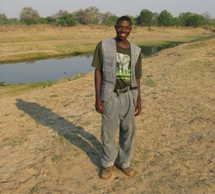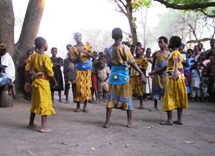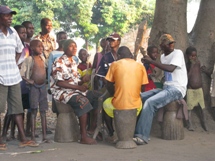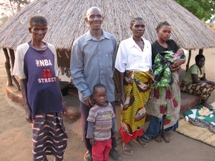Zambia (1): Day Eleven : Mwanya Bush Camp
The following morning we got up at the rather more civilised hour of 6.00 a.m. and had toast and coffee before setting out on a three hour walk with resident poacher-turned-guide, Boniface (![]() ). Along the way we saw numerous giraffe and zebra, with Boniface proving to be particularly knowledgeable on plants and trees.
). Along the way we saw numerous giraffe and zebra, with Boniface proving to be particularly knowledgeable on plants and trees.
This was a much more relaxed walk than that experienced while staying at the more formal camps situated in either South or North Luangwa (Mwanya is located in a game management area outside both of these).
On our return at 09.30 we had a normal breakfast and then relaxed until an interesting lunch of salad, chips and dove! In the afternoon we then drove to a nearby village where we were treated to a performance of dancing by a group of young girls (![]() ), accompanied by a band of musicians playing entirely home-made instruments (
), accompanied by a band of musicians playing entirely home-made instruments (![]() ). We then drove on to meet Boniface’s own family at the nearby village (
). We then drove on to meet Boniface’s own family at the nearby village (![]() ).
).
A brief game drive then took us up to our evening meal in camp (puku stew plus a French red wine).

On his travels through Zambia, very close to where we ourselves had earlier been walking, the renowned Victorian explorer, David Livingstone, first came across the Red Mahogany tree (Khayanyasica), at that time unknown to him. It is reputed that, on asking his guide the name of this tree, the latter duly replied with a name in his local language, and it was by this name that Livingstone duly recorded it in his journal. What he didn’t realise is that this word simply meant ‘I’ve no idea, mate!'
In a similar fashion, the early explorers of Australia were astounded to see a most bizarre animal, which kept its young in a pouch in front of its belly, hopping around, and enquired as to its name. Their aboriginal source didn’t know, and replied as such in his own language – ‘kangaroo’. Imagine if Livingstone had come across numerous previously undiscovered fauna and flora and had enquired of the same uninformed guide as to their local name. This would have given The Royal Society, back in London, something to think about. It’s almost Pythonesque.
| Back to previous page (Day 10) | Forward to next page (Day 12) |



